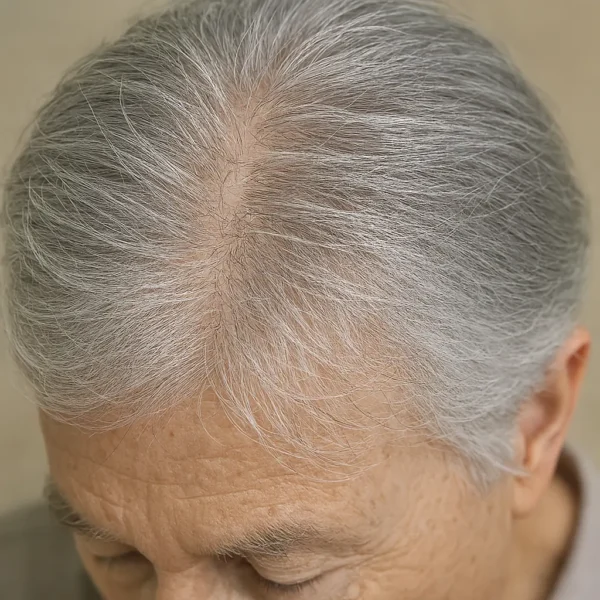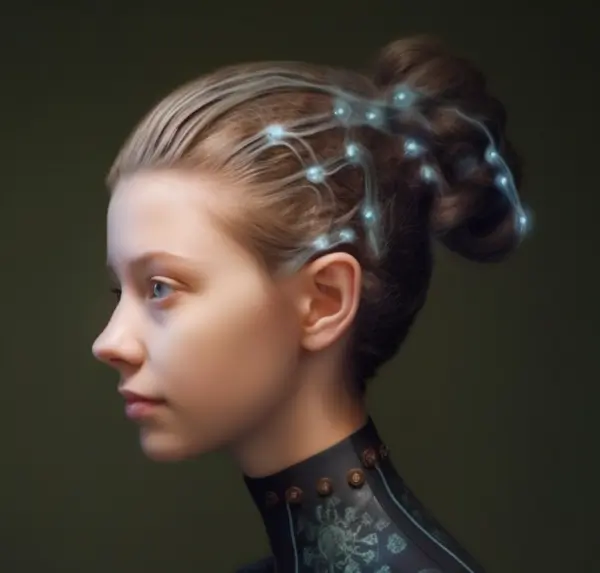A quiet form of hair loss: When people think of balding, they usually picture the familiar recessions and crowns of androgenetic alopecia (“male‑” or “female‑pattern” hair loss). Yet dermatologists have long recognised another, subtler phenomenon: hair that thins diffusely across the whole scalp in later life, even in individuals with no family history of pattern baldness. This entity – variously labelled senescent, senile, late-onset, or involutional alopecia – was first described histologically more than a decade ago as a gradual reduction in thick, terminal hairs without the miniaturisation typical of androgen‑driven loss. Although its exact clinical boundaries are still debated, senescent alopecia is increasingly studied as a model of tissue ageing in real time, offering clues to the biology of longevity and regeneration in human skin.
How common is it: Population‑based data are sparse, partly because diffuse thinning is harder to score than overt balding. In biopsy series, roughly 10–15 % of people over 70 show follicular densities below youthful baselines without the hallmarks of androgenetic alopecia. Survey studies suggest that by our eighth decade most men and women perceive their hair as “finer” or “sparser”, even when pattern loss is absent. Intriguingly, twin analyses indicate that chronological age, rather than hormonal milieu or inherited androgen hormone sensitivity, is the strongest predictor of this diffuse thinning pattern.
Defining features of Senescent Alopecia: Dermoscopically, senescent alopecia presents as a uniform decrease in shaft diameter with preserved follicular openings and a relatively normal anagen‑to‑telogen ratio. Histology shows fewer terminal hairs, but there is little fibrosis or inflammation. Gene‑expression profiling has revealed a molecular signature distinct from both youthful scalp and androgenetic alopecia: more than 600 transcripts are uniquely altered, including pathways for oxidative phosphorylation, DNA‑damage response and extracellular‑matrix remodelling. These findings argue that senescent alopecia is not merely late‑onset pattern baldness but rather, it is a separate age‑related biology.
The cellular mechanics of ageing follicles: Hair follicles are miniature organs that cycle through growth (anagen), regression (catagen) and rest (telogen). Their lifelong renewal depends on a pool of epithelial hair‑follicle stem cells (HFSCs) and mesenchymal dermal‑papilla cells. Age disrupts this partnership in at least four, partly overlapping ways:
Stem‑cell exhaustion and quiescence: Single‑cell and lineage‑tracing studies show that HFSCs lose both number and regenerative competence with age. Some remain, but they become locked in a deeper quiescence, partly through altered Wnt, BMP and FOXC1 signalling within the niche.Cellular senescence and the SASP: Repeated oxidative and replicative stress triggers a p16^INK4a‑positive senescent state in HFSCs and dermal‑papilla cells. Senescent cells secrete a senescence‑associated secretory phenotype (SASP) rich in IL‑6, matrix metalloproteinases (MMPs) and osteopontin, which can act as a double‑edged sword – impairing local stem‑cell function, yet paradoxically stimulating neighbouring follicles under certain conditions.DNA‑damage and mitochondrial decline: Mitochondrial Reactive Oxygen Species (ROS) accumulates in ageing follicles. Experimental inhibition of mitochondrial complex I or of DNA‑repair proteins in mice recapitulates diffuse hair thinning, supporting a causative role for energy decline and progressive genomic instability.Niche deterioration: Ageing dermal fibroblasts lose production of growth factors such as IGF‑1 and FGF‑7. Excess or dysregulated IGF‑1, paradoxically, can also push HFSCs into senescence; a 2025 Aging Cell study found that blocking IGF‑1 signalling rejuvenated aged mouse follicles and restored thicker pelage. Matrix stiffness increases, and vascular blood supply diminishes, further shrinking the microenvironment that once nurtured vigorous hair growth. Environmental and hormonal influences: While senescent alopecia is probably not driven by androgens, other extrinsic factors accelerate or ameliorate it:
Ultraviolet radiation – UVA light can induce senescence via mTOR‑mediated pathways in dermal‑papilla cells, compounding age‑related loss; rapamycin and other mTOR inhibitors are being explored as topical drug protectants for hair growth.Nutrition and metabolism – Caloric restriction models paradoxically slow many ageing phenotypes yet can stunt hair if nutrient supply dips too low. A 2025 review on “hair longevity” argues for balanced protein, iron, zinc, vitamin D and omega‑3 intake to maintain anagen duration in later life.Systemic inflammation – Chronic low‑grade “inflammageing” elevates cytokine biochemical signals including IL‑1β and TNFα, both known to antagonize anagen hair growth.Medications – Polypharmacy (taking multiple drugs) in older adults includes antihypertensives, anticoagulants and retinoids that may tip marginal follicles into a telogen resting state. Distinguishing senescent alopecia from pattern hair loss in clinic: Because many septuagenarians have both androgenetic alopecia changes and intrinsic ageing, the two conditions often overlap. Dermatologists rely on a combination of history (early‑life onset alopecia suggests pattern loss), family background, hormonal evaluation when appropriate, dermatoscopy and the pattern of miniaturization. Taking a scalp biopsy is reserved for ambiguous cases or research settings; the presence of miniaturised follicles with perifollicular fibrosis points to androgenetic alopecia, whereas uniform shaft thinning, but with intact healthy sebaceous glands, supports senescent alopecia.
Current management toolbox: There is no drug formally licensed for senescent alopecia, but several strategies have been suggested from broader anti‑ageing or hair‑growth research:
Minoxidil: Topical minoxidil lengthens anagen hair growth duration irrespective of androgen status and remains the first‑line option. Its vasodilatory and mitochondrial‑K_ATP‑channel effects partly counteract niche deterioration.Low‑level light therapy: Red‑light (630–680 nm) devices may increase ATP and reduce oxidative stress in dermal papillae. Randomised trials in mixed populations show modest gains in hair density over six months, and response rates appear age‑independent.Senotherapeutics: Drugs that purge senescent cells (senolytics) or blunt their SASP (senomorphics) are of great interest. In mouse models, navitoclax and dasatinib‑quercetin combinations improved fur density, while topical rapamycin delayed the onset of thinning. Human pilot studies are under way for rapamycin and the natural flavonoid fisetin.Growth‑factor modulation: Recombinant osteopontin, inspired by findings that senescent melanocytes drive robust anagen re‑entry via this ligand, is in early‑phase clinical trials. Conversely, blocking excessive IGF‑1 signalling restored HFSC activity in preclinical work.Lifestyle and scalp care: Because ageing follicles are vulnerable to cumulative insults, some dermatologists advocate a “hair longevity” framework: balanced nutrition, stress management, gentle cleansing, UV protection, avoidance of chronic traction hair styles, and treatment of scalp micro‑inflammation. Expected Future Research Developments: Basic science continues to reveal fresh molecular levers:
Epigenetic rejuvenation – Partial reprogramming with Yamanaka factors or small‑molecule analogues restores chromatin youthful patterns in aged HFSCs without tumorigenesis in mice. As such, anti-aging treatments developed for rejuvenating organs and other tissues may also work for hair follicles.Gene editing – Loss of the adaptor protein Dab2 accelerates follicle ageing; CRISPR‑mediated restoration of Dab2 function reversed thinning in murine skin, spotlighting new genetic targets where drug could be developed.Biomechanical cues – Softening the extracellular matrix with injectable collagenases revived anagen in ex‑vivo human follicles. Whether this would work consistently in humans is difficult to say, but it is an area of active research.Exosome therapy – One recent study has suggested that aging dermal papilla cells can be rejuventaed using exosomes made from dermal sheath cup cells, suggesting cell therapy and cell derived products could be used to rejuvenate aging follicles.Microbiome manipulation – Ageing scalps show shifts toward Corynebacterium‑dominant communities; development of probiotic lotions aim to recalibrate sebum metabolism and inflammatory tone. Living with senescent alopecia: For many, diffuse age‑related thinning is chiefly a cosmetic concern; but hair also serves thermoregulatory and psychosocial roles. Clinicians therefore endorse realistic counselling: therapies may thicken hair modestly, but they are unlikely to restore youthful volume. Regular reassessment is important, as the boundary between senescent and pattern alopecia can blur, warranting combined approaches.
Conclusions: Senescent alopecia is a window into how human tissues fail, or (mal)adapt, with time. By teasing apart stem‑cell exhaustion, cellular senescence, oxidative stress and niche decay, researchers are not only inching towards better hair treatments, but also illuminating principles applicable to wound healing, organ regeneration and age‑related disease at large. As senotherapeutics, gene‑editing tools and holistic “hair‑longevity” regimens progress from bench to bedside, the hope is that future octogenarians will keep more of their strands, and that the lessons learned may benefit the rest of the body, too.
Bibliography
11711645 {11711645:X8ECNUS3},{11711645:CE5GEYZZ},{11711645:ZMUZRG6Q},{11711645:NJ8UVX2E},{11711645:R8WGDU9D},{11711645:V4PNAKWP},{11711645:Z3GAS762},{11711645:ERAMZY74},{11711645:23PU765W},{11711645:QVU35IJW},{11711645:IYIW7GER},{11711645:L4WVYPYH},{11711645:GIP9C3HJ},{11711645:PFTL95XG} 1 vancouver 50 date asc 1886 https://www.keratin.com/wp-content/plugins/zotpress/ %7B%22status%22%3A%22success%22%2C%22updateneeded%22%3Afalse%2C%22instance%22%3Afalse%2C%22meta%22%3A%7B%22request_last%22%3A0%2C%22request_next%22%3A0%2C%22used_cache%22%3Atrue%7D%2C%22data%22%3A%5B%7B%22key%22%3A%22X8ECNUS3%22%2C%22library%22%3A%7B%22id%22%3A11711645%7D%2C%22meta%22%3A%7B%22creatorSummary%22%3A%22Tr%5Cu00fceb%22%2C%22parsedDate%22%3A%222009-01%22%2C%22numChildren%22%3A0%7D%2C%22bib%22%3A%22%26lt%3Bdiv%20class%3D%26quot%3Bcsl-bib-body%26quot%3B%20style%3D%26quot%3Bline-height%3A%201.35%3B%20%26quot%3B%26gt%3B%5Cn%20%20%26lt%3Bdiv%20class%3D%26quot%3Bcsl-entry%26quot%3B%20style%3D%26quot%3Bclear%3A%20left%3B%20%26quot%3B%26gt%3B%5Cn%20%20%20%20%26lt%3Bdiv%20class%3D%26quot%3Bcsl-left-margin%26quot%3B%20style%3D%26quot%3Bfloat%3A%20left%3B%20padding-right%3A%200.5em%3B%20text-align%3A%20right%3B%20width%3A%201em%3B%26quot%3B%26gt%3B1.%26lt%3B%5C%2Fdiv%26gt%3B%26lt%3Bdiv%20class%3D%26quot%3Bcsl-right-inline%26quot%3B%20style%3D%26quot%3Bmargin%3A%200%20.4em%200%201.5em%3B%26quot%3B%26gt%3BTr%26%23xFC%3Beb%20RM.%20Oxidative%20stress%20in%20ageing%20of%20hair.%20Int%20J%20Trichology.%202009%20Jan%3B1%281%29%3A6%26%23x2013%3B14.%26lt%3B%5C%2Fdiv%26gt%3B%5Cn%20%20%20%26lt%3B%5C%2Fdiv%26gt%3B%5Cn%26lt%3B%5C%2Fdiv%26gt%3B%22%2C%22data%22%3A%7B%22itemType%22%3A%22journalArticle%22%2C%22title%22%3A%22Oxidative%20stress%20in%20ageing%20of%20hair%22%2C%22creators%22%3A%5B%7B%22creatorType%22%3A%22author%22%2C%22firstName%22%3A%22Ralph%20M.%22%2C%22lastName%22%3A%22Tr%5Cu00fceb%22%7D%5D%2C%22abstractNote%22%3A%22Experimental%20evidence%20supports%20the%20hypothesis%20that%20oxidative%20stress%20plays%20a%20major%20role%20in%20the%20ageing%20process.%20Reactive%20oxygen%20species%20are%20generated%20by%20a%20multitude%20of%20endogenous%20and%20environmental%20challenges.%20Reactive%20oxygen%20species%20or%20free%20radicals%20are%20highly%20reactive%20molecules%20that%20can%20directly%20damage%20cellular%20structural%20membranes%2C%20lipids%2C%20proteins%2C%20and%20DNA.%20The%20body%20possesses%20endogenous%20defence%20mechanisms%2C%20such%20as%20antioxidative%20enzymes%20and%20non-enzymatic%20antioxidative%20molecules%2C%20protecting%20it%20from%20free%20radicals%20by%20reducing%20and%20neutralizing%20them.%20With%20age%2C%20the%20production%20of%20free%20radicals%20increases%2C%20while%20the%20endogenous%20defence%20mechanisms%20decrease.%20This%20imbalance%20leads%20to%20the%20progressive%20damage%20of%20cellular%20structures%2C%20presumably%20resulting%20in%20the%20ageing%20phenotype.%20Ageing%20of%20hair%20manifests%20as%20decrease%20of%20melanocyte%20function%20or%20graying%2C%20and%20decrease%20in%20hair%20production%20or%20alopecia.%20There%20is%20circumstantial%20evidence%20that%20oxidative%20stress%20may%20be%20a%20pivotal%20mechanism%20contributing%20to%20hair%20graying%20and%20hair%20loss.%20New%20insights%20into%20the%20role%20and%20prevention%20of%20oxidative%20stress%20could%20open%20new%20strategies%20for%20intervention%20and%20reversal%20of%20the%20hair%20graying%20process%20and%20age-dependent%20alopecia.%22%2C%22date%22%3A%222009-01%22%2C%22language%22%3A%22eng%22%2C%22DOI%22%3A%2210.4103%5C%2F0974-7753.51923%22%2C%22ISSN%22%3A%220974-9241%22%2C%22url%22%3A%22%22%2C%22collections%22%3A%5B%22BMCZ6SI5%22%5D%2C%22dateModified%22%3A%222025-07-17T15%3A52%3A17Z%22%7D%7D%2C%7B%22key%22%3A%22CE5GEYZZ%22%2C%22library%22%3A%7B%22id%22%3A11711645%7D%2C%22meta%22%3A%7B%22creatorSummary%22%3A%22Whiting%22%2C%22parsedDate%22%3A%222011%22%2C%22numChildren%22%3A0%7D%2C%22bib%22%3A%22%26lt%3Bdiv%20class%3D%26quot%3Bcsl-bib-body%26quot%3B%20style%3D%26quot%3Bline-height%3A%201.35%3B%20%26quot%3B%26gt%3B%5Cn%20%20%26lt%3Bdiv%20class%3D%26quot%3Bcsl-entry%26quot%3B%20style%3D%26quot%3Bclear%3A%20left%3B%20%26quot%3B%26gt%3B%5Cn%20%20%20%20%26lt%3Bdiv%20class%3D%26quot%3Bcsl-left-margin%26quot%3B%20style%3D%26quot%3Bfloat%3A%20left%3B%20padding-right%3A%200.5em%3B%20text-align%3A%20right%3B%20width%3A%201em%3B%26quot%3B%26gt%3B1.%26lt%3B%5C%2Fdiv%26gt%3B%26lt%3Bdiv%20class%3D%26quot%3Bcsl-right-inline%26quot%3B%20style%3D%26quot%3Bmargin%3A%200%20.4em%200%201.5em%3B%26quot%3B%26gt%3BWhiting%20DA.%20How%20real%20is%20senescent%20alopecia%3F%20A%20histopathologic%20approach.%20Clin%20Dermatol.%202011%3B29%281%29%3A49%26%23x2013%3B53.%26lt%3B%5C%2Fdiv%26gt%3B%5Cn%20%20%20%26lt%3B%5C%2Fdiv%26gt%3B%5Cn%26lt%3B%5C%2Fdiv%26gt%3B%22%2C%22data%22%3A%7B%22itemType%22%3A%22journalArticle%22%2C%22title%22%3A%22How%20real%20is%20senescent%20alopecia%3F%20A%20histopathologic%20approach%22%2C%22creators%22%3A%5B%7B%22creatorType%22%3A%22author%22%2C%22firstName%22%3A%22David%20A.%22%2C%22lastName%22%3A%22Whiting%22%7D%5D%2C%22abstractNote%22%3A%22Senescent%20alopecia%20was%20originally%20thought%20to%20affect%20people%20aged%2050%20years%20or%20older%20with%20no%20family%20history%20or%20evidence%20of%20pattern%20balding.%20It%20was%20described%20as%20a%20diffuse%20thinning%20involving%20the%20whole%20scalp%20due%20to%20a%20steady%20decrease%20in%20thick%20terminal%20hairs%2C%20but%20without%20evidence%20of%20increased%20miniaturization.%20Senescent%20alopecia%20is%20not%20a%20primary%20diagnosis%20in%20this%20clinic.%20Most%20possible%20examples%20of%20it%20are%20assumed%20to%20be%20androgenetic%20or%20diffuse%20alopecia.%20In%20the%20study%20reported%20here%2C%20horizontal%20sections%20of%202149%20scalp%20specimens%20from%20individuals%20with%20male%20and%20female%20pattern%20and%20diffuse%20alopecia%2C%20as%20well%20as%20from%20normal%20controls%2C%20were%20examined%2C%20and%20their%20follicular%20counts%20were%20recorded%20and%20sorted%20into%20decades.%20The%20decade%20of%2020%20to%2029%20years%20contained%20a%20significant%20number%20of%20patients%20and%20was%20used%20for%20baseline%20follicular%20counts%20for%20comparison%20with%20all%20succeeding%20decades%20up%20to%20age%2099%20years.%20A%20reduction%20of%2015%25%20below%20baseline%20was%20considered%20significant.%20In%2010.6%25%20of%20patients%20with%20male%20pattern%20alopecia%2C%20the%20age%20of%20onset%20of%20a%20significant%20reduction%20in%20follicular%20counts%20was%2050%20years%3B%20in%205.7%25%20of%20patients%20with%20female%20pattern%20alopecia%20it%20was%2070%20years%2C%20and%20in%202.0%25%20of%20patients%20with%20diffuse%20alopecia%20it%20was%2080%20years.%20These%20data%20suggest%20that%20most%20cases%20of%20significant%20hair%20loss%20in%20the%20elderly%20are%20androgen%20driven.%20The%20few%20patients%20with%20deteriorating%20diffuse%20alopecia%20may%20be%20the%20exception.%20The%20study%20concluded%20that%20old%20age%20is%20not%20a%20significant%20cause%20of%20hair%20loss.%22%2C%22date%22%3A%222011%22%2C%22language%22%3A%22eng%22%2C%22DOI%22%3A%2210.1016%5C%2Fj.clindermatol.2010.07.007%22%2C%22ISSN%22%3A%221879-1131%22%2C%22url%22%3A%22%22%2C%22collections%22%3A%5B%22BMCZ6SI5%22%5D%2C%22dateModified%22%3A%222025-07-17T15%3A42%3A17Z%22%7D%7D%2C%7B%22key%22%3A%22ZMUZRG6Q%22%2C%22library%22%3A%7B%22id%22%3A11711645%7D%2C%22meta%22%3A%7B%22creatorSummary%22%3A%22Karnik%20et%20al.%22%2C%22parsedDate%22%3A%222013-11%22%2C%22numChildren%22%3A0%7D%2C%22bib%22%3A%22%26lt%3Bdiv%20class%3D%26quot%3Bcsl-bib-body%26quot%3B%20style%3D%26quot%3Bline-height%3A%201.35%3B%20%26quot%3B%26gt%3B%5Cn%20%20%26lt%3Bdiv%20class%3D%26quot%3Bcsl-entry%26quot%3B%20style%3D%26quot%3Bclear%3A%20left%3B%20%26quot%3B%26gt%3B%5Cn%20%20%20%20%26lt%3Bdiv%20class%3D%26quot%3Bcsl-left-margin%26quot%3B%20style%3D%26quot%3Bfloat%3A%20left%3B%20padding-right%3A%200.5em%3B%20text-align%3A%20right%3B%20width%3A%201em%3B%26quot%3B%26gt%3B1.%26lt%3B%5C%2Fdiv%26gt%3B%26lt%3Bdiv%20class%3D%26quot%3Bcsl-right-inline%26quot%3B%20style%3D%26quot%3Bmargin%3A%200%20.4em%200%201.5em%3B%26quot%3B%26gt%3BKarnik%20P%2C%20Shah%20S%2C%20Dvorkin-Wininger%20Y%2C%20Oshtory%20S%2C%20Mirmirani%20P.%20Microarray%20analysis%20of%20androgenetic%20and%20senescent%20alopecia%3A%20comparison%20of%20gene%20expression%20shows%20two%20distinct%20profiles.%20J%20Dermatol%20Sci.%202013%20Nov%3B72%282%29%3A183%26%23x2013%3B6.%26lt%3B%5C%2Fdiv%26gt%3B%5Cn%20%20%20%26lt%3B%5C%2Fdiv%26gt%3B%5Cn%26lt%3B%5C%2Fdiv%26gt%3B%22%2C%22data%22%3A%7B%22itemType%22%3A%22journalArticle%22%2C%22title%22%3A%22Microarray%20analysis%20of%20androgenetic%20and%20senescent%20alopecia%3A%20comparison%20of%20gene%20expression%20shows%20two%20distinct%20profiles%22%2C%22creators%22%3A%5B%7B%22creatorType%22%3A%22author%22%2C%22firstName%22%3A%22Pratima%22%2C%22lastName%22%3A%22Karnik%22%7D%2C%7B%22creatorType%22%3A%22author%22%2C%22firstName%22%3A%22Selam%22%2C%22lastName%22%3A%22Shah%22%7D%2C%7B%22creatorType%22%3A%22author%22%2C%22firstName%22%3A%22Yevgeniya%22%2C%22lastName%22%3A%22Dvorkin-Wininger%22%7D%2C%7B%22creatorType%22%3A%22author%22%2C%22firstName%22%3A%22Shaheen%22%2C%22lastName%22%3A%22Oshtory%22%7D%2C%7B%22creatorType%22%3A%22author%22%2C%22firstName%22%3A%22Paradi%22%2C%22lastName%22%3A%22Mirmirani%22%7D%5D%2C%22abstractNote%22%3A%22%22%2C%22date%22%3A%222013-11%22%2C%22language%22%3A%22eng%22%2C%22DOI%22%3A%2210.1016%5C%2Fj.jdermsci.2013.06.017%22%2C%22ISSN%22%3A%221873-569X%22%2C%22url%22%3A%22%22%2C%22collections%22%3A%5B%22BMCZ6SI5%22%5D%2C%22dateModified%22%3A%222025-07-17T15%3A47%3A19Z%22%7D%7D%2C%7B%22key%22%3A%22NJ8UVX2E%22%2C%22library%22%3A%7B%22id%22%3A11711645%7D%2C%22meta%22%3A%7B%22creatorSummary%22%3A%22Torres%22%2C%22parsedDate%22%3A%222015%22%2C%22numChildren%22%3A0%7D%2C%22bib%22%3A%22%26lt%3Bdiv%20class%3D%26quot%3Bcsl-bib-body%26quot%3B%20style%3D%26quot%3Bline-height%3A%201.35%3B%20%26quot%3B%26gt%3B%5Cn%20%20%26lt%3Bdiv%20class%3D%26quot%3Bcsl-entry%26quot%3B%20style%3D%26quot%3Bclear%3A%20left%3B%20%26quot%3B%26gt%3B%5Cn%20%20%20%20%26lt%3Bdiv%20class%3D%26quot%3Bcsl-left-margin%26quot%3B%20style%3D%26quot%3Bfloat%3A%20left%3B%20padding-right%3A%200.5em%3B%20text-align%3A%20right%3B%20width%3A%201em%3B%26quot%3B%26gt%3B1.%26lt%3B%5C%2Fdiv%26gt%3B%26lt%3Bdiv%20class%3D%26quot%3Bcsl-right-inline%26quot%3B%20style%3D%26quot%3Bmargin%3A%200%20.4em%200%201.5em%3B%26quot%3B%26gt%3BTorres%20F.%20Androgenetic%2C%20diffuse%20and%20senescent%20alopecia%20in%20men%3A%20practical%20evaluation%20and%20management.%20Curr%20Probl%20Dermatol.%202015%3B47%3A33%26%23x2013%3B44.%26lt%3B%5C%2Fdiv%26gt%3B%5Cn%20%20%20%26lt%3B%5C%2Fdiv%26gt%3B%5Cn%26lt%3B%5C%2Fdiv%26gt%3B%22%2C%22data%22%3A%7B%22itemType%22%3A%22journalArticle%22%2C%22title%22%3A%22Androgenetic%2C%20diffuse%20and%20senescent%20alopecia%20in%20men%3A%20practical%20evaluation%20and%20management%22%2C%22creators%22%3A%5B%7B%22creatorType%22%3A%22author%22%2C%22firstName%22%3A%22Fernanda%22%2C%22lastName%22%3A%22Torres%22%7D%5D%2C%22abstractNote%22%3A%22Male%20baldness%20is%20the%20most%20common%20diagnosis%20in%20men%20that%20present%20with%20hair%20loss.%20It%20is%20a%20genetically%20determined%20condition%20that%20is%20clearly%20an%20androgen-dependent%20trait%2C%20mainly%20driven%20by%20dihydrotestosterone%20action%20on%20the%20hair%20follicles%2C%20leading%20to%20miniaturization.%20Although%20in%20general%20this%20condition%20is%20socially%20accepted%20as%20a%20natural%20process%20in%20a%20man%26%23039%3Bs%20life%2C%20for%20some%20individuals%20it%20might%20significantly%20impact%20quality%20of%20life%2C%20reducing%20self-esteem%20and%20increasing%20stress.%20This%20chapter%20encompasses%20the%20most%20important%20aspects%20of%20the%20practical%20evaluation%20%28clinical%20features%2C%20trichoscopy%2C%20trichogram%2C%20histopathology%2C%20relevant%20blood%20tests%29%20and%20management%20of%20male%20baldness%2C%20diffuse%20baldness%20and%20senescent%20alopecia.%22%2C%22date%22%3A%222015%22%2C%22language%22%3A%22eng%22%2C%22DOI%22%3A%2210.1159%5C%2F000369403%22%2C%22ISSN%22%3A%221662-2944%22%2C%22url%22%3A%22%22%2C%22collections%22%3A%5B%22BMCZ6SI5%22%5D%2C%22dateModified%22%3A%222025-07-17T15%3A52%3A43Z%22%7D%7D%2C%7B%22key%22%3A%22R8WGDU9D%22%2C%22library%22%3A%7B%22id%22%3A11711645%7D%2C%22meta%22%3A%7B%22creatorSummary%22%3A%22Fernandez-Flores%20et%20al.%22%2C%22parsedDate%22%3A%222019-07%22%2C%22numChildren%22%3A0%7D%2C%22bib%22%3A%22%26lt%3Bdiv%20class%3D%26quot%3Bcsl-bib-body%26quot%3B%20style%3D%26quot%3Bline-height%3A%201.35%3B%20%26quot%3B%26gt%3B%5Cn%20%20%26lt%3Bdiv%20class%3D%26quot%3Bcsl-entry%26quot%3B%20style%3D%26quot%3Bclear%3A%20left%3B%20%26quot%3B%26gt%3B%5Cn%20%20%20%20%26lt%3Bdiv%20class%3D%26quot%3Bcsl-left-margin%26quot%3B%20style%3D%26quot%3Bfloat%3A%20left%3B%20padding-right%3A%200.5em%3B%20text-align%3A%20right%3B%20width%3A%201em%3B%26quot%3B%26gt%3B1.%26lt%3B%5C%2Fdiv%26gt%3B%26lt%3Bdiv%20class%3D%26quot%3Bcsl-right-inline%26quot%3B%20style%3D%26quot%3Bmargin%3A%200%20.4em%200%201.5em%3B%26quot%3B%26gt%3BFernandez-Flores%20A%2C%20Saeb-Lima%20M%2C%20Cassarino%20DS.%20Histopathology%20of%20aging%20of%20the%20hair%20follicle.%20J%20Cutan%20Pathol.%202019%20July%3B46%287%29%3A508%26%23x2013%3B19.%26lt%3B%5C%2Fdiv%26gt%3B%5Cn%20%20%20%26lt%3B%5C%2Fdiv%26gt%3B%5Cn%26lt%3B%5C%2Fdiv%26gt%3B%22%2C%22data%22%3A%7B%22itemType%22%3A%22journalArticle%22%2C%22title%22%3A%22Histopathology%20of%20aging%20of%20the%20hair%20follicle%22%2C%22creators%22%3A%5B%7B%22creatorType%22%3A%22author%22%2C%22firstName%22%3A%22Angel%22%2C%22lastName%22%3A%22Fernandez-Flores%22%7D%2C%7B%22creatorType%22%3A%22author%22%2C%22firstName%22%3A%22Marcela%22%2C%22lastName%22%3A%22Saeb-Lima%22%7D%2C%7B%22creatorType%22%3A%22author%22%2C%22firstName%22%3A%22David%20S.%22%2C%22lastName%22%3A%22Cassarino%22%7D%5D%2C%22abstractNote%22%3A%22Hair%20follicles%20experience%20several%20changes%20with%20aging%2C%20the%20most%20noticeable%20of%20which%20is%20graying%20of%20the%20hair%20shaft%20due%20to%20loss%20of%20melanin.%20Additional%20changes%20in%20the%20diameter%20and%20length%20of%20the%20hair%20have%20contributed%20to%20the%20concept%20of%20senescent%20alopecia%2C%20which%20is%20different%20from%20androgenetic%20alopecia%20according%20to%20most.%20Graying%20happens%20in%20most%20individuals%2C%20although%20in%20different%20grades%20and%20starting%20at%20different%20ages.%20It%20is%20related%20to%20a%20decrease%20in%20the%20number%20and%20activity%20of%20the%20melanocytes%20of%20the%20hair%20bulb%2C%20which%20eventually%20completely%20disappear%20from%20the%20bulb%20of%20the%20white%20hair.%20Residual%20non-active%20melanocytes%20remain%20in%20the%20outer%20root%20sheath%20and%20in%20the%20bulge%2C%20which%20allows%20for%20repigmentation%20of%20the%20hair%20under%20certain%20stimuli%20or%20conditions.%22%2C%22date%22%3A%222019-07%22%2C%22language%22%3A%22eng%22%2C%22DOI%22%3A%2210.1111%5C%2Fcup.13467%22%2C%22ISSN%22%3A%221600-0560%22%2C%22url%22%3A%22%22%2C%22collections%22%3A%5B%22BMCZ6SI5%22%5D%2C%22dateModified%22%3A%222025-07-17T16%3A04%3A48Z%22%7D%7D%2C%7B%22key%22%3A%22V4PNAKWP%22%2C%22library%22%3A%7B%22id%22%3A11711645%7D%2C%22meta%22%3A%7B%22creatorSummary%22%3A%22Choi%22%2C%22parsedDate%22%3A%222020-05-24%22%2C%22numChildren%22%3A0%7D%2C%22bib%22%3A%22%26lt%3Bdiv%20class%3D%26quot%3Bcsl-bib-body%26quot%3B%20style%3D%26quot%3Bline-height%3A%201.35%3B%20%26quot%3B%26gt%3B%5Cn%20%20%26lt%3Bdiv%20class%3D%26quot%3Bcsl-entry%26quot%3B%20style%3D%26quot%3Bclear%3A%20left%3B%20%26quot%3B%26gt%3B%5Cn%20%20%20%20%26lt%3Bdiv%20class%3D%26quot%3Bcsl-left-margin%26quot%3B%20style%3D%26quot%3Bfloat%3A%20left%3B%20padding-right%3A%200.5em%3B%20text-align%3A%20right%3B%20width%3A%201em%3B%26quot%3B%26gt%3B1.%26lt%3B%5C%2Fdiv%26gt%3B%26lt%3Bdiv%20class%3D%26quot%3Bcsl-right-inline%26quot%3B%20style%3D%26quot%3Bmargin%3A%200%20.4em%200%201.5em%3B%26quot%3B%26gt%3BChoi%20YJ.%20Shedding%20Light%20on%20the%20Effects%20of%20Calorie%20Restriction%20and%20its%20Mimetics%20on%20Skin%20Biology.%20Nutrients.%202020%20May%2024%3B12%285%29%3A1529.%26lt%3B%5C%2Fdiv%26gt%3B%5Cn%20%20%20%26lt%3B%5C%2Fdiv%26gt%3B%5Cn%26lt%3B%5C%2Fdiv%26gt%3B%22%2C%22data%22%3A%7B%22itemType%22%3A%22journalArticle%22%2C%22title%22%3A%22Shedding%20Light%20on%20the%20Effects%20of%20Calorie%20Restriction%20and%20its%20Mimetics%20on%20Skin%20Biology%22%2C%22creators%22%3A%5B%7B%22creatorType%22%3A%22author%22%2C%22firstName%22%3A%22Yeon%20Ja%22%2C%22lastName%22%3A%22Choi%22%7D%5D%2C%22abstractNote%22%3A%22During%20the%20aging%20process%20of%20an%20organism%2C%20the%20skin%20gradually%20loses%20its%20structural%20and%20functional%20characteristics.%20The%20skin%20becomes%20more%20fragile%20and%20vulnerable%20to%20damage%2C%20which%20may%20contribute%20to%20age-related%20diseases%20and%20even%20death.%20Skin%20aging%20is%20aggravated%20by%20the%20fact%20that%20the%20skin%20is%20in%20direct%20contact%20with%20extrinsic%20factors%2C%20such%20as%20ultraviolet%20irradiation.%20While%20calorie%20restriction%20%28CR%29%20is%20the%20most%20effective%20intervention%20to%20extend%20the%20lifespan%20of%20organisms%20and%20prevent%20age-related%20disorders%2C%20its%20effects%20on%20cutaneous%20aging%20and%20disorders%20are%20poorly%20understood.%20This%20review%20discusses%20the%20effects%20of%20CR%20and%20its%20alternative%20dietary%20intake%20on%20skin%20biology%2C%20with%20a%20focus%20on%20skin%20aging.%20CR%20structurally%20and%20functionally%20affects%20most%20of%20the%20skin%20and%20has%20been%20reported%20to%20rescue%20both%20age-related%20and%20photo-induced%20changes.%20The%20anti-inflammatory%2C%20anti-oxidative%2C%20stem%20cell%20maintenance%2C%20and%20metabolic%20activities%20of%20CR%20contribute%20to%20its%20beneficial%20effects%20on%20the%20skin.%20To%20the%20best%20of%20the%20author%26%23039%3Bs%20knowledge%2C%20the%20effects%20of%20fasting%20or%20a%20specific%20nutrient-restricted%20diet%20on%20skin%20aging%20have%20not%20been%20evaluated%3B%20these%20strategies%20offer%20benefits%20in%20wound%20healing%20and%20inflammatory%20skin%20diseases.%20In%20addition%2C%20well-known%20CR%20mimetics%2C%20including%20resveratrol%2C%20metformin%2C%20rapamycin%2C%20and%20peroxisome%20proliferator-activated%20receptor%20agonists%2C%20show%20CR-like%20prevention%20against%20skin%20aging.%20An%20overview%20of%20the%20role%20of%20CR%20in%20skin%20biology%20will%20provide%20valuable%20insights%20that%20would%20eventually%20lead%20to%20improvements%20in%20skin%20health.%22%2C%22date%22%3A%222020-05-24%22%2C%22language%22%3A%22eng%22%2C%22DOI%22%3A%2210.3390%5C%2Fnu12051529%22%2C%22ISSN%22%3A%222072-6643%22%2C%22url%22%3A%22%22%2C%22collections%22%3A%5B%22BMCZ6SI5%22%5D%2C%22dateModified%22%3A%222025-07-17T15%3A45%3A41Z%22%7D%7D%2C%7B%22key%22%3A%22Z3GAS762%22%2C%22library%22%3A%7B%22id%22%3A11711645%7D%2C%22meta%22%3A%7B%22creatorSummary%22%3A%22Villani%20et%20al.%22%2C%22parsedDate%22%3A%222022%22%2C%22numChildren%22%3A0%7D%2C%22bib%22%3A%22%26lt%3Bdiv%20class%3D%26quot%3Bcsl-bib-body%26quot%3B%20style%3D%26quot%3Bline-height%3A%201.35%3B%20%26quot%3B%26gt%3B%5Cn%20%20%26lt%3Bdiv%20class%3D%26quot%3Bcsl-entry%26quot%3B%20style%3D%26quot%3Bclear%3A%20left%3B%20%26quot%3B%26gt%3B%5Cn%20%20%20%20%26lt%3Bdiv%20class%3D%26quot%3Bcsl-left-margin%26quot%3B%20style%3D%26quot%3Bfloat%3A%20left%3B%20padding-right%3A%200.5em%3B%20text-align%3A%20right%3B%20width%3A%201em%3B%26quot%3B%26gt%3B1.%26lt%3B%5C%2Fdiv%26gt%3B%26lt%3Bdiv%20class%3D%26quot%3Bcsl-right-inline%26quot%3B%20style%3D%26quot%3Bmargin%3A%200%20.4em%200%201.5em%3B%26quot%3B%26gt%3BVillani%20A%2C%20Ferrillo%20M%2C%20Fabbrocini%20G%2C%20Ocampo-Garza%20SS%2C%20Scalvenzi%20M%2C%20Ruggiero%20A.%20Hair%20Aging%20and%20Hair%20Disorders%20in%20Elderly%20Patients.%20Int%20J%20Trichology.%202022%3B14%286%29%3A191%26%23x2013%3B6.%26lt%3B%5C%2Fdiv%26gt%3B%5Cn%20%20%20%26lt%3B%5C%2Fdiv%26gt%3B%5Cn%26lt%3B%5C%2Fdiv%26gt%3B%22%2C%22data%22%3A%7B%22itemType%22%3A%22journalArticle%22%2C%22title%22%3A%22Hair%20Aging%20and%20Hair%20Disorders%20in%20Elderly%20Patients%22%2C%22creators%22%3A%5B%7B%22creatorType%22%3A%22author%22%2C%22firstName%22%3A%22Alessia%22%2C%22lastName%22%3A%22Villani%22%7D%2C%7B%22creatorType%22%3A%22author%22%2C%22firstName%22%3A%22Maria%22%2C%22lastName%22%3A%22Ferrillo%22%7D%2C%7B%22creatorType%22%3A%22author%22%2C%22firstName%22%3A%22Gabriella%22%2C%22lastName%22%3A%22Fabbrocini%22%7D%2C%7B%22creatorType%22%3A%22author%22%2C%22firstName%22%3A%22Sonia%20Sof%5Cu00eda%22%2C%22lastName%22%3A%22Ocampo-Garza%22%7D%2C%7B%22creatorType%22%3A%22author%22%2C%22firstName%22%3A%22Massimiliano%22%2C%22lastName%22%3A%22Scalvenzi%22%7D%2C%7B%22creatorType%22%3A%22author%22%2C%22firstName%22%3A%22Angelo%22%2C%22lastName%22%3A%22Ruggiero%22%7D%5D%2C%22abstractNote%22%3A%22Hair%20loss%20in%20elderly%20patients%20is%20a%20common%20complaint.%20It%20can%20be%20related%20to%20different%20conditions%20that%20affect%20patients%26%23039%3B%20quality%20of%20life%20and%20represents%20a%20challenge%20for%20dermatologists.%20It%20affects%20both%20men%20and%20women%20during%20the%20aging%20process%20with%20an%20estimated%20percentage%20of%20balding%20after%2065%20years%20of%20age%20of%2053%25%20and%2037%25%2C%20respectively.%20Androgenetic%20alopecia%2C%20frontal%20fibrosing%20alopecia%2C%20senile%20alopecia%2C%20and%20erosive%20pustular%20dermatosis%20of%20the%20scalp%20are%20the%20hair%20diseases%20most%20frequently%20described%20in%20this%20age%20group.%20The%20objective%20of%20this%20review%20is%20to%20summarize%20the%20current%20knowledge%20about%20alopecia%20affecting%20elderly%20patients%2C%20differentiating%20between%20chronological%20hair%20aging%20signs%20and%20pathological%20changes%2C%20to%20help%20clinicians%2C%20offer%20an%20adequate%20management%20of%20these%20disorders%20to%20their%20patients.%22%2C%22date%22%3A%222022%22%2C%22language%22%3A%22eng%22%2C%22DOI%22%3A%2210.4103%5C%2Fijt.ijt_90_21%22%2C%22ISSN%22%3A%220974-7753%22%2C%22url%22%3A%22%22%2C%22collections%22%3A%5B%22BMCZ6SI5%22%5D%2C%22dateModified%22%3A%222025-07-17T15%3A44%3A47Z%22%7D%7D%2C%7B%22key%22%3A%2223PU765W%22%2C%22library%22%3A%7B%22id%22%3A11711645%7D%2C%22meta%22%3A%7B%22creatorSummary%22%3A%22Bourezane%20and%20Bourezane%22%2C%22parsedDate%22%3A%222023%22%2C%22numChildren%22%3A0%7D%2C%22bib%22%3A%22%26lt%3Bdiv%20class%3D%26quot%3Bcsl-bib-body%26quot%3B%20style%3D%26quot%3Bline-height%3A%201.35%3B%20%26quot%3B%26gt%3B%5Cn%20%20%26lt%3Bdiv%20class%3D%26quot%3Bcsl-entry%26quot%3B%20style%3D%26quot%3Bclear%3A%20left%3B%20%26quot%3B%26gt%3B%5Cn%20%20%20%20%26lt%3Bdiv%20class%3D%26quot%3Bcsl-left-margin%26quot%3B%20style%3D%26quot%3Bfloat%3A%20left%3B%20padding-right%3A%200.5em%3B%20text-align%3A%20right%3B%20width%3A%201em%3B%26quot%3B%26gt%3B1.%26lt%3B%5C%2Fdiv%26gt%3B%26lt%3Bdiv%20class%3D%26quot%3Bcsl-right-inline%26quot%3B%20style%3D%26quot%3Bmargin%3A%200%20.4em%200%201.5em%3B%26quot%3B%26gt%3BBourezane%20Y%2C%20Bourezane%20I.%20Proposition%20of%20a%20New%20Terminology%20of%20Senile%20Alopecia%3A%20Physiologic%20Alopecia.%20Int%20J%20Trichology.%202023%3B15%281%29%3A41%26%23x2013%3B2.%26lt%3B%5C%2Fdiv%26gt%3B%5Cn%20%20%20%26lt%3B%5C%2Fdiv%26gt%3B%5Cn%26lt%3B%5C%2Fdiv%26gt%3B%22%2C%22data%22%3A%7B%22itemType%22%3A%22journalArticle%22%2C%22title%22%3A%22Proposition%20of%20a%20New%20Terminology%20of%20Senile%20Alopecia%3A%20Physiologic%20Alopecia%22%2C%22creators%22%3A%5B%7B%22creatorType%22%3A%22author%22%2C%22firstName%22%3A%22Yazid%22%2C%22lastName%22%3A%22Bourezane%22%7D%2C%7B%22creatorType%22%3A%22author%22%2C%22firstName%22%3A%22Ines%22%2C%22lastName%22%3A%22Bourezane%22%7D%5D%2C%22abstractNote%22%3A%22%22%2C%22date%22%3A%222023%22%2C%22language%22%3A%22eng%22%2C%22DOI%22%3A%2210.4103%5C%2Fijt.ijt_54_21%22%2C%22ISSN%22%3A%220974-7753%22%2C%22url%22%3A%22%22%2C%22collections%22%3A%5B%22BMCZ6SI5%22%5D%2C%22dateModified%22%3A%222025-07-17T15%3A43%3A23Z%22%7D%7D%2C%7B%22key%22%3A%22ERAMZY74%22%2C%22library%22%3A%7B%22id%22%3A11711645%7D%2C%22meta%22%3A%7B%22creatorSummary%22%3A%22Wang%20et%20al.%22%2C%22parsedDate%22%3A%222023-06%22%2C%22numChildren%22%3A0%7D%2C%22bib%22%3A%22%26lt%3Bdiv%20class%3D%26quot%3Bcsl-bib-body%26quot%3B%20style%3D%26quot%3Bline-height%3A%201.35%3B%20%26quot%3B%26gt%3B%5Cn%20%20%26lt%3Bdiv%20class%3D%26quot%3Bcsl-entry%26quot%3B%20style%3D%26quot%3Bclear%3A%20left%3B%20%26quot%3B%26gt%3B%5Cn%20%20%20%20%26lt%3Bdiv%20class%3D%26quot%3Bcsl-left-margin%26quot%3B%20style%3D%26quot%3Bfloat%3A%20left%3B%20padding-right%3A%200.5em%3B%20text-align%3A%20right%3B%20width%3A%201em%3B%26quot%3B%26gt%3B1.%26lt%3B%5C%2Fdiv%26gt%3B%26lt%3Bdiv%20class%3D%26quot%3Bcsl-right-inline%26quot%3B%20style%3D%26quot%3Bmargin%3A%200%20.4em%200%201.5em%3B%26quot%3B%26gt%3BWang%20X%2C%20Ramos%20R%2C%20Phan%20AQ%2C%20Yamaga%20K%2C%20Flesher%20JL%2C%20Jiang%20S%2C%20et%20al.%20Signalling%20by%20senescent%20melanocytes%20hyperactivates%20hair%20growth.%20Nature.%202023%20June%3B618%287966%29%3A808%26%23x2013%3B17.%26lt%3B%5C%2Fdiv%26gt%3B%5Cn%20%20%20%26lt%3B%5C%2Fdiv%26gt%3B%5Cn%26lt%3B%5C%2Fdiv%26gt%3B%22%2C%22data%22%3A%7B%22itemType%22%3A%22journalArticle%22%2C%22title%22%3A%22Signalling%20by%20senescent%20melanocytes%20hyperactivates%20hair%20growth%22%2C%22creators%22%3A%5B%7B%22creatorType%22%3A%22author%22%2C%22firstName%22%3A%22Xiaojie%22%2C%22lastName%22%3A%22Wang%22%7D%2C%7B%22creatorType%22%3A%22author%22%2C%22firstName%22%3A%22Raul%22%2C%22lastName%22%3A%22Ramos%22%7D%2C%7B%22creatorType%22%3A%22author%22%2C%22firstName%22%3A%22Anne%20Q.%22%2C%22lastName%22%3A%22Phan%22%7D%2C%7B%22creatorType%22%3A%22author%22%2C%22firstName%22%3A%22Kosuke%22%2C%22lastName%22%3A%22Yamaga%22%7D%2C%7B%22creatorType%22%3A%22author%22%2C%22firstName%22%3A%22Jessica%20L.%22%2C%22lastName%22%3A%22Flesher%22%7D%2C%7B%22creatorType%22%3A%22author%22%2C%22firstName%22%3A%22Shan%22%2C%22lastName%22%3A%22Jiang%22%7D%2C%7B%22creatorType%22%3A%22author%22%2C%22firstName%22%3A%22Ji%20Won%22%2C%22lastName%22%3A%22Oh%22%7D%2C%7B%22creatorType%22%3A%22author%22%2C%22firstName%22%3A%22Suoqin%22%2C%22lastName%22%3A%22Jin%22%7D%2C%7B%22creatorType%22%3A%22author%22%2C%22firstName%22%3A%22Sohail%22%2C%22lastName%22%3A%22Jahid%22%7D%2C%7B%22creatorType%22%3A%22author%22%2C%22firstName%22%3A%22Chen-Hsiang%22%2C%22lastName%22%3A%22Kuan%22%7D%2C%7B%22creatorType%22%3A%22author%22%2C%22firstName%22%3A%22Truman%20Kt%22%2C%22lastName%22%3A%22Nguyen%22%7D%2C%7B%22creatorType%22%3A%22author%22%2C%22firstName%22%3A%22Heidi%20Y.%22%2C%22lastName%22%3A%22Liang%22%7D%2C%7B%22creatorType%22%3A%22author%22%2C%22firstName%22%3A%22Nitish%20Udupi%22%2C%22lastName%22%3A%22Shettigar%22%7D%2C%7B%22creatorType%22%3A%22author%22%2C%22firstName%22%3A%22Renzhi%22%2C%22lastName%22%3A%22Hou%22%7D%2C%7B%22creatorType%22%3A%22author%22%2C%22firstName%22%3A%22Kevin%20H.%22%2C%22lastName%22%3A%22Tran%22%7D%2C%7B%22creatorType%22%3A%22author%22%2C%22firstName%22%3A%22Andrew%22%2C%22lastName%22%3A%22Nguyen%22%7D%2C%7B%22creatorType%22%3A%22author%22%2C%22firstName%22%3A%22Kimberly%20N.%22%2C%22lastName%22%3A%22Vu%22%7D%2C%7B%22creatorType%22%3A%22author%22%2C%22firstName%22%3A%22Jennie%20L.%22%2C%22lastName%22%3A%22Phung%22%7D%2C%7B%22creatorType%22%3A%22author%22%2C%22firstName%22%3A%22Jonard%20P.%22%2C%22lastName%22%3A%22Ingal%22%7D%2C%7B%22creatorType%22%3A%22author%22%2C%22firstName%22%3A%22Katelyn%20M.%22%2C%22lastName%22%3A%22Levitt%22%7D%2C%7B%22creatorType%22%3A%22author%22%2C%22firstName%22%3A%22Xiaoling%22%2C%22lastName%22%3A%22Cao%22%7D%2C%7B%22creatorType%22%3A%22author%22%2C%22firstName%22%3A%22Yingzi%22%2C%22lastName%22%3A%22Liu%22%7D%2C%7B%22creatorType%22%3A%22author%22%2C%22firstName%22%3A%22Zhili%22%2C%22lastName%22%3A%22Deng%22%7D%2C%7B%22creatorType%22%3A%22author%22%2C%22firstName%22%3A%22Nobuhiko%22%2C%22lastName%22%3A%22Taguchi%22%7D%2C%7B%22creatorType%22%3A%22author%22%2C%22firstName%22%3A%22Vanessa%20M.%22%2C%22lastName%22%3A%22Scarfone%22%7D%2C%7B%22creatorType%22%3A%22author%22%2C%22firstName%22%3A%22Guangfang%22%2C%22lastName%22%3A%22Wang%22%7D%2C%7B%22creatorType%22%3A%22author%22%2C%22firstName%22%3A%22Kara%20Nicole%22%2C%22lastName%22%3A%22Paolilli%22%7D%2C%7B%22creatorType%22%3A%22author%22%2C%22firstName%22%3A%22Xiaoyang%22%2C%22lastName%22%3A%22Wang%22%7D%2C%7B%22creatorType%22%3A%22author%22%2C%22firstName%22%3A%22Christian%20F.%22%2C%22lastName%22%3A%22Guerrero-Juarez%22%7D%2C%7B%22creatorType%22%3A%22author%22%2C%22firstName%22%3A%22Ryan%20T.%22%2C%22lastName%22%3A%22Davis%22%7D%2C%7B%22creatorType%22%3A%22author%22%2C%22firstName%22%3A%22Elyse%20Noelani%22%2C%22lastName%22%3A%22Greenberg%22%7D%2C%7B%22creatorType%22%3A%22author%22%2C%22firstName%22%3A%22Rolando%22%2C%22lastName%22%3A%22Ruiz-Vega%22%7D%2C%7B%22creatorType%22%3A%22author%22%2C%22firstName%22%3A%22Priya%22%2C%22lastName%22%3A%22Vasudeva%22%7D%2C%7B%22creatorType%22%3A%22author%22%2C%22firstName%22%3A%22Rabi%22%2C%22lastName%22%3A%22Murad%22%7D%2C%7B%22creatorType%22%3A%22author%22%2C%22firstName%22%3A%22Lily%20Halida%20Putri%22%2C%22lastName%22%3A%22Widyastuti%22%7D%2C%7B%22creatorType%22%3A%22author%22%2C%22firstName%22%3A%22Hye-Lim%22%2C%22lastName%22%3A%22Lee%22%7D%2C%7B%22creatorType%22%3A%22author%22%2C%22firstName%22%3A%22Kevin%20J.%22%2C%22lastName%22%3A%22McElwee%22%7D%2C%7B%22creatorType%22%3A%22author%22%2C%22firstName%22%3A%22Alain-Pierre%22%2C%22lastName%22%3A%22Gadeau%22%7D%2C%7B%22creatorType%22%3A%22author%22%2C%22firstName%22%3A%22Devon%20A.%22%2C%22lastName%22%3A%22Lawson%22%7D%2C%7B%22creatorType%22%3A%22author%22%2C%22firstName%22%3A%22Bogi%22%2C%22lastName%22%3A%22Andersen%22%7D%2C%7B%22creatorType%22%3A%22author%22%2C%22firstName%22%3A%22Ali%22%2C%22lastName%22%3A%22Mortazavi%22%7D%2C%7B%22creatorType%22%3A%22author%22%2C%22firstName%22%3A%22Zhengquan%22%2C%22lastName%22%3A%22Yu%22%7D%2C%7B%22creatorType%22%3A%22author%22%2C%22firstName%22%3A%22Qing%22%2C%22lastName%22%3A%22Nie%22%7D%2C%7B%22creatorType%22%3A%22author%22%2C%22firstName%22%3A%22Takahiro%22%2C%22lastName%22%3A%22Kunisada%22%7D%2C%7B%22creatorType%22%3A%22author%22%2C%22firstName%22%3A%22Michael%22%2C%22lastName%22%3A%22Karin%22%7D%2C%7B%22creatorType%22%3A%22author%22%2C%22firstName%22%3A%22Jan%22%2C%22lastName%22%3A%22Tuckermann%22%7D%2C%7B%22creatorType%22%3A%22author%22%2C%22firstName%22%3A%22Jeffrey%20D.%22%2C%22lastName%22%3A%22Esko%22%7D%2C%7B%22creatorType%22%3A%22author%22%2C%22firstName%22%3A%22Anand%20K.%22%2C%22lastName%22%3A%22Ganesan%22%7D%2C%7B%22creatorType%22%3A%22author%22%2C%22firstName%22%3A%22Ji%22%2C%22lastName%22%3A%22Li%22%7D%2C%7B%22creatorType%22%3A%22author%22%2C%22firstName%22%3A%22Maksim%20V.%22%2C%22lastName%22%3A%22Plikus%22%7D%5D%2C%22abstractNote%22%3A%22Niche%20signals%20maintain%20stem%20cells%20in%20a%20prolonged%20quiescence%20or%20transiently%20activate%20them%20for%20proper%20regeneration1.%20Altering%20balanced%20niche%20signalling%20can%20lead%20to%20regenerative%20disorders.%20Melanocytic%20skin%20nevi%20in%20human%20often%20display%20excessive%20hair%20growth%2C%20suggesting%20hair%20stem%20cell%20hyperactivity.%20Here%2C%20using%20genetic%20mouse%20models%20of%20nevi2%2C3%2C%20we%20show%20that%20dermal%20clusters%20of%20senescent%20melanocytes%20drive%20epithelial%20hair%20stem%20cells%20to%20exit%20quiescence%20and%20change%20their%20transcriptome%20and%20composition%2C%20potently%20enhancing%20hair%20renewal.%20Nevus%20melanocytes%20activate%20a%20distinct%20secretome%2C%20enriched%20for%20signalling%20factors.%20Osteopontin%2C%20the%20leading%20nevus%20signalling%20factor%2C%20is%20both%20necessary%20and%20sufficient%20to%20induce%20hair%20growth.%20Injection%20of%20osteopontin%20or%20its%20genetic%20overexpression%20is%20sufficient%20to%20induce%20robust%20hair%20growth%20in%20mice%2C%20whereas%20germline%20and%20conditional%20deletions%20of%20either%20osteopontin%20or%20CD44%2C%20its%20cognate%20receptor%20on%20epithelial%20hair%20cells%2C%20rescue%20enhanced%20hair%20growth%20induced%20by%20dermal%20nevus%20melanocytes.%20Osteopontin%20is%20overexpressed%20in%20human%20hairy%20nevi%2C%20and%20it%20stimulates%20new%20growth%20of%20human%20hair%20follicles.%20Although%20broad%20accumulation%20of%20senescent%20cells%2C%20such%20as%20upon%20ageing%20or%20genotoxic%20stress%2C%20is%20detrimental%20for%20the%20regenerative%20capacity%20of%20tissue4%2C%20we%20show%20that%20signalling%20by%20senescent%20cell%20clusters%20can%20potently%20enhance%20the%20activity%20of%20adjacent%20intact%20stem%20cells%20and%20stimulate%20tissue%20renewal.%20This%20finding%20identifies%20senescent%20cells%20and%20their%20secretome%20as%20an%20attractive%20therapeutic%20target%20in%20regenerative%20disorders.%22%2C%22date%22%3A%222023-06%22%2C%22language%22%3A%22eng%22%2C%22DOI%22%3A%2210.1038%5C%2Fs41586-023-06172-8%22%2C%22ISSN%22%3A%221476-4687%22%2C%22url%22%3A%22%22%2C%22collections%22%3A%5B%22BMCZ6SI5%22%5D%2C%22dateModified%22%3A%222025-07-17T15%3A48%3A29Z%22%7D%7D%2C%7B%22key%22%3A%22IYIW7GER%22%2C%22library%22%3A%7B%22id%22%3A11711645%7D%2C%22meta%22%3A%7B%22creatorSummary%22%3A%22Liu%20et%20al.%22%2C%22parsedDate%22%3A%222024-01%22%2C%22numChildren%22%3A0%7D%2C%22bib%22%3A%22%26lt%3Bdiv%20class%3D%26quot%3Bcsl-bib-body%26quot%3B%20style%3D%26quot%3Bline-height%3A%201.35%3B%20%26quot%3B%26gt%3B%5Cn%20%20%26lt%3Bdiv%20class%3D%26quot%3Bcsl-entry%26quot%3B%20style%3D%26quot%3Bclear%3A%20left%3B%20%26quot%3B%26gt%3B%5Cn%20%20%20%20%26lt%3Bdiv%20class%3D%26quot%3Bcsl-left-margin%26quot%3B%20style%3D%26quot%3Bfloat%3A%20left%3B%20padding-right%3A%200.5em%3B%20text-align%3A%20right%3B%20width%3A%201em%3B%26quot%3B%26gt%3B1.%26lt%3B%5C%2Fdiv%26gt%3B%26lt%3Bdiv%20class%3D%26quot%3Bcsl-right-inline%26quot%3B%20style%3D%26quot%3Bmargin%3A%200%20.4em%200%201.5em%3B%26quot%3B%26gt%3BLiu%20F%2C%20Liu%20S%2C%20Luo%20X%2C%20Fan%20Z%2C%20Huang%20S%2C%20Deng%20F%2C%20et%20al.%20Combatting%20ageing%20in%20dermal%20papilla%20cells%20and%20promoting%20hair%20follicle%20regeneration%20using%20exosomes%20from%20human%20hair%20follicle%20dermal%20sheath%20cup%20cells.%20Exp%20Dermatol.%202024%20Jan%3B33%281%29%3Ae14948.%26lt%3B%5C%2Fdiv%26gt%3B%5Cn%20%20%20%26lt%3B%5C%2Fdiv%26gt%3B%5Cn%26lt%3B%5C%2Fdiv%26gt%3B%22%2C%22data%22%3A%7B%22itemType%22%3A%22journalArticle%22%2C%22title%22%3A%22Combatting%20ageing%20in%20dermal%20papilla%20cells%20and%20promoting%20hair%20follicle%20regeneration%20using%20exosomes%20from%20human%20hair%20follicle%20dermal%20sheath%20cup%20cells%22%2C%22creators%22%3A%5B%7B%22creatorType%22%3A%22author%22%2C%22firstName%22%3A%22Fang%22%2C%22lastName%22%3A%22Liu%22%7D%2C%7B%22creatorType%22%3A%22author%22%2C%22firstName%22%3A%22Si%22%2C%22lastName%22%3A%22Liu%22%7D%2C%7B%22creatorType%22%3A%22author%22%2C%22firstName%22%3A%22Xiaohua%22%2C%22lastName%22%3A%22Luo%22%7D%2C%7B%22creatorType%22%3A%22author%22%2C%22firstName%22%3A%22Zirui%22%2C%22lastName%22%3A%22Fan%22%7D%2C%7B%22creatorType%22%3A%22author%22%2C%22firstName%22%3A%22Shaobin%22%2C%22lastName%22%3A%22Huang%22%7D%2C%7B%22creatorType%22%3A%22author%22%2C%22firstName%22%3A%22Fangqi%22%2C%22lastName%22%3A%22Deng%22%7D%2C%7B%22creatorType%22%3A%22author%22%2C%22firstName%22%3A%22Huanliang%22%2C%22lastName%22%3A%22Liu%22%7D%2C%7B%22creatorType%22%3A%22author%22%2C%22firstName%22%3A%22Ge%22%2C%22lastName%22%3A%22Shi%22%7D%5D%2C%22abstractNote%22%3A%22Dermal%20papilla%20cells%20%28DPCs%29%20undergo%20premature%20ageing%20in%20androgenetic%20alopecia%20and%20senescent%20alopecia.%20As%20critical%20components%20of%20hair%20follicle%20reconstruction%2C%20DPCs%20are%20also%20prone%20to%20senescence%20in%5Cu00a0vitro%2C%20resulting%20in%20a%20diminished%20hair%20follicle%20inductivity%20capacity.%20Dermal%20sheath%20cup%20cells%20%28DSCCs%29%2C%20a%20specific%20subset%20of%20hair%20follicle%20mesenchymal%20stem%20cells%2C%20intimately%20linked%20to%20the%20function%20of%20DPCs.%20The%20primary%20objective%20of%20this%20research%20is%20to%20investigate%20the%20anti-ageing%20effect%20of%20exosomes%20derived%20from%20DSCCs%20%28ExoDSCCs%20%29%20on%20DPCs.%20Exosomes%20were%20utilized%20to%20treat%20H2%20O2%20-induced%20DPCs%20or%20long-generation%20DPCs%28P10%29.%20Our%20findings%20demonstrate%20that%20ExoDSCCs%28P3%29%20promote%20the%20proliferation%2C%20viability%20and%20migration%20of%20senescent%20DPCs%20while%20inhibiting%20cell%20apoptosis.%20The%20expression%20of%20senescence%20marker%20SA-%5Cu03b2-Gal%20were%20significantly%20downregulated%20in%20senescent%20DPCs.%20When%20treated%20with%20ExoDSCCs%28P3%29%20%2C%20expression%20of%20inducibility%20related%20markers%20alkaline%20phosphatase%20and%20Versican%20were%20significantly%20upregulated.%20Additionally%2C%20ExoDSCCs%28P3%29%20activated%20the%20Wnt%5C%2F%5Cu03b2-catenin%20signalling%20in%5Cu00a0vitro.%20In%20patch%20assay%2C%20ExoDSCCs%28P3%29%20significantly%20promoted%20hair%20follicle%20reconstruction%20in%20senescent%20DPCs.%20In%20summary%2C%20our%20work%20highlights%20that%20ExoDSCCs%28P3%29%20may%20restore%20the%20biological%20functions%20and%20improve%20the%20hair%20follicle%20induction%20ability%20of%20senescent%20DPCs.%20Therefore%2C%20ExoDSCCs%28P3%29%20may%20represent%20a%20new%20strategy%20for%20intervening%20in%20the%20ageing%20process%20of%20DPCs%2C%20contributing%20to%20the%20prevention%20of%20senile%20alopecia.%22%2C%22date%22%3A%222024-01%22%2C%22language%22%3A%22eng%22%2C%22DOI%22%3A%2210.1111%5C%2Fexd.14948%22%2C%22ISSN%22%3A%221600-0625%22%2C%22url%22%3A%22%22%2C%22collections%22%3A%5B%22BMCZ6SI5%22%5D%2C%22dateModified%22%3A%222025-07-17T15%3A55%3A32Z%22%7D%7D%2C%7B%22key%22%3A%22QVU35IJW%22%2C%22library%22%3A%7B%22id%22%3A11711645%7D%2C%22meta%22%3A%7B%22creatorSummary%22%3A%22Lee%20and%20Choi%22%2C%22parsedDate%22%3A%222024-02%22%2C%22numChildren%22%3A0%7D%2C%22bib%22%3A%22%26lt%3Bdiv%20class%3D%26quot%3Bcsl-bib-body%26quot%3B%20style%3D%26quot%3Bline-height%3A%201.35%3B%20%26quot%3B%26gt%3B%5Cn%20%20%26lt%3Bdiv%20class%3D%26quot%3Bcsl-entry%26quot%3B%20style%3D%26quot%3Bclear%3A%20left%3B%20%26quot%3B%26gt%3B%5Cn%20%20%20%20%26lt%3Bdiv%20class%3D%26quot%3Bcsl-left-margin%26quot%3B%20style%3D%26quot%3Bfloat%3A%20left%3B%20padding-right%3A%200.5em%3B%20text-align%3A%20right%3B%20width%3A%201em%3B%26quot%3B%26gt%3B1.%26lt%3B%5C%2Fdiv%26gt%3B%26lt%3Bdiv%20class%3D%26quot%3Bcsl-right-inline%26quot%3B%20style%3D%26quot%3Bmargin%3A%200%20.4em%200%201.5em%3B%26quot%3B%26gt%3BLee%20JH%2C%20Choi%20S.%20Deciphering%20the%20molecular%20mechanisms%20of%20stem%20cell%20dynamics%20in%20hair%20follicle%20regeneration.%20Exp%20Mol%20Med.%202024%20Feb%3B56%281%29%3A110%26%23x2013%3B7.%26lt%3B%5C%2Fdiv%26gt%3B%5Cn%20%20%20%26lt%3B%5C%2Fdiv%26gt%3B%5Cn%26lt%3B%5C%2Fdiv%26gt%3B%22%2C%22data%22%3A%7B%22itemType%22%3A%22journalArticle%22%2C%22title%22%3A%22Deciphering%20the%20molecular%20mechanisms%20of%20stem%20cell%20dynamics%20in%20hair%20follicle%20regeneration%22%2C%22creators%22%3A%5B%7B%22creatorType%22%3A%22author%22%2C%22firstName%22%3A%22Jung%20Hyun%22%2C%22lastName%22%3A%22Lee%22%7D%2C%7B%22creatorType%22%3A%22author%22%2C%22firstName%22%3A%22Sekyu%22%2C%22lastName%22%3A%22Choi%22%7D%5D%2C%22abstractNote%22%3A%22Hair%20follicles%2C%20which%20are%20connected%20to%20sebaceous%20glands%20in%20the%20skin%2C%20undergo%20cyclic%20periods%20of%20regeneration%2C%20degeneration%2C%20and%20rest%20throughout%20adult%20life%20in%20mammals.%20The%20crucial%20function%20of%20hair%20follicle%20stem%20cells%20is%20to%20maintain%20these%20hair%20growth%20cycles.%20Another%20vital%20aspect%20is%20the%20activity%20of%20melanocyte%20stem%20cells%2C%20which%20differentiate%20into%20melanin-producing%20melanocytes%2C%20contributing%20to%20skin%20and%20hair%20pigmentation.%20Sebaceous%20gland%20stem%20cells%20also%20have%20a%20pivotal%20role%20in%20maintaining%20the%20skin%20barrier%20by%20regenerating%20mature%20sebocytes.%20These%20stem%20cells%20are%20maintained%20in%20a%20specialized%20microenvironment%20or%20niche%20and%20are%20regulated%20by%20internal%20and%20external%20signals%2C%20determining%20their%20dynamic%20behaviors%20in%20homeostasis%20and%20hair%20follicle%20regeneration.%20The%20activity%20of%20these%20stem%20cells%20is%20tightly%20controlled%20by%20various%20factors%20secreted%20by%20the%20niche%20components%20around%20the%20hair%20follicles%2C%20as%20well%20as%20immune-mediated%20damage%20signals%2C%20aging%2C%20metabolic%20status%2C%20and%20stress.%20In%20this%20study%2C%20we%20review%20these%20diverse%20stem%20cell%20regulatory%20and%20related%20molecular%20mechanisms%20of%20hair%20regeneration%20and%20disease%20conditions.%20Molecular%20insights%20would%20provide%20new%20perspectives%20on%20the%20disease%20mechanisms%20as%20well%20as%20hair%20and%20skin%20disorder%20treatment.%22%2C%22date%22%3A%222024-02%22%2C%22language%22%3A%22eng%22%2C%22DOI%22%3A%2210.1038%5C%2Fs12276-023-01151-5%22%2C%22ISSN%22%3A%222092-6413%22%2C%22url%22%3A%22%22%2C%22collections%22%3A%5B%22BMCZ6SI5%22%5D%2C%22dateModified%22%3A%222025-07-17T15%3A47%3A54Z%22%7D%7D%2C%7B%22key%22%3A%22L4WVYPYH%22%2C%22library%22%3A%7B%22id%22%3A11711645%7D%2C%22meta%22%3A%7B%22creatorSummary%22%3A%22Roy%20et%20al.%22%2C%22parsedDate%22%3A%222024-05-03%22%2C%22numChildren%22%3A0%7D%2C%22bib%22%3A%22%26lt%3Bdiv%20class%3D%26quot%3Bcsl-bib-body%26quot%3B%20style%3D%26quot%3Bline-height%3A%201.35%3B%20%26quot%3B%26gt%3B%5Cn%20%20%26lt%3Bdiv%20class%3D%26quot%3Bcsl-entry%26quot%3B%20style%3D%26quot%3Bclear%3A%20left%3B%20%26quot%3B%26gt%3B%5Cn%20%20%20%20%26lt%3Bdiv%20class%3D%26quot%3Bcsl-left-margin%26quot%3B%20style%3D%26quot%3Bfloat%3A%20left%3B%20padding-right%3A%200.5em%3B%20text-align%3A%20right%3B%20width%3A%201em%3B%26quot%3B%26gt%3B1.%26lt%3B%5C%2Fdiv%26gt%3B%26lt%3Bdiv%20class%3D%26quot%3Bcsl-right-inline%26quot%3B%20style%3D%26quot%3Bmargin%3A%200%20.4em%200%201.5em%3B%26quot%3B%26gt%3BRoy%20S%2C%20Mehta%20D%2C%20Paradkar%20A%2C%20Chovatiya%20G%2C%20Waghmare%20SK.%20Dab2%20%28Disabled-2%29%2C%20an%20adaptor%20protein%2C%20regulates%20self-renewal%20of%20hair%20follicle%20stem%20cells.%20Commun%20Biol.%202024%20May%203%3B7%281%29%3A525.%26lt%3B%5C%2Fdiv%26gt%3B%5Cn%20%20%20%26lt%3B%5C%2Fdiv%26gt%3B%5Cn%26lt%3B%5C%2Fdiv%26gt%3B%22%2C%22data%22%3A%7B%22itemType%22%3A%22journalArticle%22%2C%22title%22%3A%22Dab2%20%28Disabled-2%29%2C%20an%20adaptor%20protein%2C%20regulates%20self-renewal%20of%20hair%20follicle%20stem%20cells%22%2C%22creators%22%3A%5B%7B%22creatorType%22%3A%22author%22%2C%22firstName%22%3A%22Sayoni%22%2C%22lastName%22%3A%22Roy%22%7D%2C%7B%22creatorType%22%3A%22author%22%2C%22firstName%22%3A%22Darshan%22%2C%22lastName%22%3A%22Mehta%22%7D%2C%7B%22creatorType%22%3A%22author%22%2C%22firstName%22%3A%22Akshay%22%2C%22lastName%22%3A%22Paradkar%22%7D%2C%7B%22creatorType%22%3A%22author%22%2C%22firstName%22%3A%22Gopal%22%2C%22lastName%22%3A%22Chovatiya%22%7D%2C%7B%22creatorType%22%3A%22author%22%2C%22firstName%22%3A%22Sanjeev%20K.%22%2C%22lastName%22%3A%22Waghmare%22%7D%5D%2C%22abstractNote%22%3A%22Disabled%202%20%28Dab2%29%2C%20an%20adaptor%20protein%2C%20is%20up%20regulated%20in%20the%20hair%20follicle%20stem%20cells%20%28HFSCs%29%3B%20however%2C%20its%20role%20in%20any%20tissue%20stem%20cells%20has%20not%20been%20studied.%20In%20the%20present%20study%2C%20we%20have%20reported%20that%20Dab2%20conditional%20knockout%20%28Dab2-cKO%29%20mice%20exhibited%20a%20delay%20in%20the%20HF%20cycle%20due%20to%20perturbed%20activation%20of%20HFSCs.%20Further%2C%20Dab2-cKO%20mice%20showed%20a%20reduction%20in%20the%20number%20of%20HFSCs%20and%20reduced%20colony%20forming%20ability%20of%20HFSCs.%20Dab2-cKO%20mice%20showed%20extended%20quiescence%20of%20HFSCs%20concomitant%20with%20an%20increased%20expression%20of%20Nfatc1.%20Dab2-cKO%20mice%20showed%20a%20decreased%20expression%20of%20anti-aging%20genes%20such%20as%20Col17a1%2C%20decorin%2C%20Sirt2%20and%20Sirt7.%20Dab2-cKO%20mice%20did%20not%20show%20full%20hair%20coat%20recovery%20in%20aged%20mice%20thereby%20suggesting%20an%20accelerated%20aging%20process.%20Overall%2C%20we%20unveil%20for%20the%20first%20time%2C%20the%20role%20of%20Dab2%20that%20regulate%20activation%20and%20self-renewal%20of%20HFSCs.%22%2C%22date%22%3A%222024-05-03%22%2C%22language%22%3A%22eng%22%2C%22DOI%22%3A%2210.1038%5C%2Fs42003-024-06047-2%22%2C%22ISSN%22%3A%222399-3642%22%2C%22url%22%3A%22%22%2C%22collections%22%3A%5B%22BMCZ6SI5%22%5D%2C%22dateModified%22%3A%222025-07-17T15%3A50%3A07Z%22%7D%7D%2C%7B%22key%22%3A%22GIP9C3HJ%22%2C%22library%22%3A%7B%22id%22%3A11711645%7D%2C%22meta%22%3A%7B%22creatorSummary%22%3A%22Westgate%20et%20al.%22%2C%22parsedDate%22%3A%222025-03-11%22%2C%22numChildren%22%3A0%7D%2C%22bib%22%3A%22%26lt%3Bdiv%20class%3D%26quot%3Bcsl-bib-body%26quot%3B%20style%3D%26quot%3Bline-height%3A%201.35%3B%20%26quot%3B%26gt%3B%5Cn%20%20%26lt%3Bdiv%20class%3D%26quot%3Bcsl-entry%26quot%3B%20style%3D%26quot%3Bclear%3A%20left%3B%20%26quot%3B%26gt%3B%5Cn%20%20%20%20%26lt%3Bdiv%20class%3D%26quot%3Bcsl-left-margin%26quot%3B%20style%3D%26quot%3Bfloat%3A%20left%3B%20padding-right%3A%200.5em%3B%20text-align%3A%20right%3B%20width%3A%201em%3B%26quot%3B%26gt%3B1.%26lt%3B%5C%2Fdiv%26gt%3B%26lt%3Bdiv%20class%3D%26quot%3Bcsl-right-inline%26quot%3B%20style%3D%26quot%3Bmargin%3A%200%20.4em%200%201.5em%3B%26quot%3B%26gt%3BWestgate%20GE%2C%20Grohmann%20D%2C%20S%26%23xE1%3Bez%20Moya%20M.%20Hair%20Longevity-Evidence%20for%20a%20Multifactorial%20Holistic%20Approach%20to%20Managing%20Hair%20Aging%20Changes.%20J%20Clin%20Med.%202025%20Mar%2011%3B14%286%29%3A1894.%26lt%3B%5C%2Fdiv%26gt%3B%5Cn%20%20%20%26lt%3B%5C%2Fdiv%26gt%3B%5Cn%26lt%3B%5C%2Fdiv%26gt%3B%22%2C%22data%22%3A%7B%22itemType%22%3A%22journalArticle%22%2C%22title%22%3A%22Hair%20Longevity-Evidence%20for%20a%20Multifactorial%20Holistic%20Approach%20to%20Managing%20Hair%20Aging%20Changes%22%2C%22creators%22%3A%5B%7B%22creatorType%22%3A%22author%22%2C%22firstName%22%3A%22Gillian%20E.%22%2C%22lastName%22%3A%22Westgate%22%7D%2C%7B%22creatorType%22%3A%22author%22%2C%22firstName%22%3A%22Daniela%22%2C%22lastName%22%3A%22Grohmann%22%7D%2C%7B%22creatorType%22%3A%22author%22%2C%22firstName%22%3A%22Manuel%22%2C%22lastName%22%3A%22S%5Cu00e1ez%20Moya%22%7D%5D%2C%22abstractNote%22%3A%22Loss%20of%20hair%20density-hair%20thinning%20and%20balding-%20is%20typically%20referred%20to%20as%20male%20and%20female%20pattern%20alopecia.%20Causes%20include%20genetic%20predisposition%20and%20links%20to%20the%20impact%20of%20dihydrotestosterone%20on%20the%20follicle%20dermal%20papilla%2C%20which%20are%20typically%20characterized%20by%20an%20increase%20in%20the%20number%20of%20vellus%20follicles.%20Links%20to%20chronological%20aging%20are%20unclear.%20Proven%20treatments%20remain%20few%20in%20number%20and%20are%20still%20targeting%20and%20tested%20on%20those%20experiencing%20classical%20pattern%20hair%20loss.%20The%20way%20hair%20changes%20with%20aging%2C%20especially%20in%20women%2C%20can%20be%20considered%20as%20having%20a%20much%20broader%20scope.%20Trends%20in%20managing%20changes%20to%20hair%20density%2C%20length%2C%20and%20fiber%20quality%20with%20aging%20now%20mostly%20include%20cocktail%20approaches-whether%20topical%2C%20injected%2C%20or%20oral-recognizing%20that%20solutions%20are%20more%20likely%20to%20require%20a%20multifactorial%20strategy.%20This%20review%20examines%20the%20evidence%20for%20the%20more%20holistic%20approach%20to%20addressing%20unwanted%20hair%20loss%2C%20which%20includes%20nutrition%2C%20lifestyle%2C%20stress%20management%2C%20and%20scalp%20and%20hair%20care%2C%20as%20well%20as%20co-morbidities%20with%20other%20health%20concerns.%20We%20discuss%20the%20strengths%20and%20limitations%20of%20clinical%20study%20design%20to%20investigate%20efficacy%20using%20multifactorial%20holistic%20approaches.%20We%20propose%20that%20this%20strategy%20will%20contribute%20to%20the%20emerging%20concept%20of%20hair%20longevity%20in%20which%20follicle%2C%20scalp%2C%20and%20fiber%20are%20targeted%20and%20that%20maintaining%20anagen%20is%20the%20most%20appropriate%20route%20to%20achieving%20healthy%20hair%20with%20aging.%20Finally%2C%20we%20discuss%20the%20problem%20facing%20patients%20and%20consumers%20regarding%20the%20quantity%20of%20misinformation%20and%20how%20it%20influences%20choosing%20from%20a%20fast-growing%20market%20of%20solutions%20that%20bypass%20a%20pharmaceutical%20approach%20to%20hair%20thinning.%22%2C%22date%22%3A%222025-03-11%22%2C%22language%22%3A%22eng%22%2C%22DOI%22%3A%2210.3390%5C%2Fjcm14061894%22%2C%22ISSN%22%3A%222077-0383%22%2C%22url%22%3A%22%22%2C%22collections%22%3A%5B%22BMCZ6SI5%22%5D%2C%22dateModified%22%3A%222025-07-17T15%3A49%3A15Z%22%7D%7D%2C%7B%22key%22%3A%22PFTL95XG%22%2C%22library%22%3A%7B%22id%22%3A11711645%7D%2C%22meta%22%3A%7B%22creatorSummary%22%3A%22Wang%20et%20al.%22%2C%22parsedDate%22%3A%222025-07%22%2C%22numChildren%22%3A0%7D%2C%22bib%22%3A%22%26lt%3Bdiv%20class%3D%26quot%3Bcsl-bib-body%26quot%3B%20style%3D%26quot%3Bline-height%3A%201.35%3B%20%26quot%3B%26gt%3B%5Cn%20%20%26lt%3Bdiv%20class%3D%26quot%3Bcsl-entry%26quot%3B%20style%3D%26quot%3Bclear%3A%20left%3B%20%26quot%3B%26gt%3B%5Cn%20%20%20%20%26lt%3Bdiv%20class%3D%26quot%3Bcsl-left-margin%26quot%3B%20style%3D%26quot%3Bfloat%3A%20left%3B%20padding-right%3A%200.5em%3B%20text-align%3A%20right%3B%20width%3A%201em%3B%26quot%3B%26gt%3B1.%26lt%3B%5C%2Fdiv%26gt%3B%26lt%3Bdiv%20class%3D%26quot%3Bcsl-right-inline%26quot%3B%20style%3D%26quot%3Bmargin%3A%200%20.4em%200%201.5em%3B%26quot%3B%26gt%3BWang%20Y%2C%20Yang%20J%2C%20Luo%20Y%2C%20Zhao%20Z%2C%20Yuan%20Y%2C%20Li%20J%2C%20et%20al.%20Targeting%20IGF1-Induced%20Cellular%20Senescence%20to%20Rejuvenate%20Hair%20Follicle%20Aging.%20Aging%20Cell.%202025%20July%3B24%287%29%3Ae70053.%26lt%3B%5C%2Fdiv%26gt%3B%5Cn%20%20%20%26lt%3B%5C%2Fdiv%26gt%3B%5Cn%26lt%3B%5C%2Fdiv%26gt%3B%22%2C%22data%22%3A%7B%22itemType%22%3A%22journalArticle%22%2C%22title%22%3A%22Targeting%20IGF1-Induced%20Cellular%20Senescence%20to%20Rejuvenate%20Hair%20Follicle%20Aging%22%2C%22creators%22%3A%5B%7B%22creatorType%22%3A%22author%22%2C%22firstName%22%3A%22Yang%22%2C%22lastName%22%3A%22Wang%22%7D%2C%7B%22creatorType%22%3A%22author%22%2C%22firstName%22%3A%22Jian%22%2C%22lastName%22%3A%22Yang%22%7D%2C%7B%22creatorType%22%3A%22author%22%2C%22firstName%22%3A%22Yue%22%2C%22lastName%22%3A%22Luo%22%7D%2C%7B%22creatorType%22%3A%22author%22%2C%22firstName%22%3A%22Zhiqiang%22%2C%22lastName%22%3A%22Zhao%22%7D%2C%7B%22creatorType%22%3A%22author%22%2C%22firstName%22%3A%22Yawen%22%2C%22lastName%22%3A%22Yuan%22%7D%2C%7B%22creatorType%22%3A%22author%22%2C%22firstName%22%3A%22Juan%22%2C%22lastName%22%3A%22Li%22%7D%2C%7B%22creatorType%22%3A%22author%22%2C%22firstName%22%3A%22Yang%22%2C%22lastName%22%3A%22Liu%22%7D%2C%7B%22creatorType%22%3A%22author%22%2C%22firstName%22%3A%22Yong%22%2C%22lastName%22%3A%22Yi%22%7D%2C%7B%22creatorType%22%3A%22author%22%2C%22firstName%22%3A%22Xiaoke%22%2C%22lastName%22%3A%22Xu%22%7D%2C%7B%22creatorType%22%3A%22author%22%2C%22firstName%22%3A%22Yuankunyu%22%2C%22lastName%22%3A%22Lan%22%7D%2C%7B%22creatorType%22%3A%22author%22%2C%22firstName%22%3A%22Juan%22%2C%22lastName%22%3A%22Zou%22%7D%2C%7B%22creatorType%22%3A%22author%22%2C%22firstName%22%3A%22Qintong%22%2C%22lastName%22%3A%22Li%22%7D%2C%7B%22creatorType%22%3A%22author%22%2C%22firstName%22%3A%22Liang%22%2C%22lastName%22%3A%22Wang%22%7D%2C%7B%22creatorType%22%3A%22author%22%2C%22firstName%22%3A%22Yang%22%2C%22lastName%22%3A%22Pan%22%7D%2C%7B%22creatorType%22%3A%22author%22%2C%22firstName%22%3A%22Yuanhan%22%2C%22lastName%22%3A%22Yang%22%7D%2C%7B%22creatorType%22%3A%22author%22%2C%22firstName%22%3A%22Muzhao%22%2C%22lastName%22%3A%22Xiong%22%7D%2C%7B%22creatorType%22%3A%22author%22%2C%22firstName%22%3A%22Min%22%2C%22lastName%22%3A%22Wu%22%7D%2C%7B%22creatorType%22%3A%22author%22%2C%22firstName%22%3A%22Jinsong%22%2C%22lastName%22%3A%22Li%22%7D%2C%7B%22creatorType%22%3A%22author%22%2C%22firstName%22%3A%22Weiyuxin%22%2C%22lastName%22%3A%22Li%22%7D%2C%7B%22creatorType%22%3A%22author%22%2C%22firstName%22%3A%22Yujun%22%2C%22lastName%22%3A%22Zhang%22%7D%2C%7B%22creatorType%22%3A%22author%22%2C%22firstName%22%3A%22Yang%22%2C%22lastName%22%3A%22Cao%22%7D%2C%7B%22creatorType%22%3A%22author%22%2C%22firstName%22%3A%22Yi%22%2C%22lastName%22%3A%22Zhu%22%7D%2C%7B%22creatorType%22%3A%22author%22%2C%22firstName%22%3A%22Zhi-Xiong%20Jim%22%2C%22lastName%22%3A%22Xiao%22%7D%5D%2C%22abstractNote%22%3A%22The%20insulin-like%20growth%20factor-1%20%28IGF-1%29%20signaling%20pathway%20is%20known%20as%20a%20potent%20aging%20modifier%2C%20disruption%20of%20which%20consistently%20associates%20with%20lifespan%20extension%20across%20diverse%20species.%20Despite%20this%20established%20association%2C%20the%20mechanisms%20by%20which%20IGF-1%20signaling%20modulates%20organ%20aging%20remain%20poorly%20understood.%20In%20this%20study%2C%20we%20assessed%20age-related%20changes%20in%20IGF-1%20expression%20across%20multiple%20organs%20in%20mice%20and%20identified%20a%20more%20prominent%20increase%20in%20skin%20IGF-1%20levels%20with%20aging-a%20phenomenon%20also%20observed%20in%20human%20skin.%20To%20explore%20the%20consequences%20of%20elevated%20IGF-1%2C%20we%20developed%20transgenic%20mice%20ectopically%20expressing%20human%20IGF-1%20in%20the%20epidermis%2C%20driven%20by%20the%20bovine%20keratin%205%20promoter%20%28IGF-1%20Tg%29.%20These%20mice%20exhibited%20premature%20aging%20of%20hair%20follicles%2C%20as%20evidenced%20by%20accelerated%20hair%20graying%20and%20loss.%20Single-cell%20RNA%20sequencing%20analyses%20of%20dorsal%20skin%20highlighted%20an%20upsurge%20in%20cellular%20senescence%20markers%20and%20the%20senescence-associated%20secretory%20phenotype%20%28SASP%29%20in%20hair%20follicle%20stem%20cells%20%28HFSCs%29%2C%20alongside%20a%20decline%20in%20hair%20growth%20and%20HFSC%20exhaustion.%20Our%20findings%20indicate%20that%20excessive%20IGF-1%20triggers%20HFSC%20senescence%2C%20thereby%20disrupting%20hair%20follicle%20homeostasis.%20Remarkably%2C%20interventions%20in%20IGF-1%20signaling%20via%20downstream%20mechanisms-specifically%20blocking%20Ac-p53%20activation%20via%20SIRT1%20overexpression%20or%20senolytic%20treatment%20for%20senescent%20cell%20clearance%2C%20or%20reducing%20IGF-1%20through%20dietary%20restriction-significantly%20reduced%20senescence%20markers%2C%20mitigated%20premature%20hair%20follicle%20aging%20phenotypes%2C%20and%20restored%20the%20stem%20cell%20pool.%20Our%20findings%20provide%20fundamental%20insights%20into%20the%20biological%20processes%20of%20hair%20aging%20and%20highlight%20the%20therapeutic%20promise%20of%20targeted%20interventions%20to%20rejuvenate%20aged%20HFSCs%20and%20promote%20hair%20follicle%20health.%22%2C%22date%22%3A%222025-07%22%2C%22language%22%3A%22eng%22%2C%22DOI%22%3A%2210.1111%5C%2Facel.70053%22%2C%22ISSN%22%3A%221474-9726%22%2C%22url%22%3A%22%22%2C%22collections%22%3A%5B%22BMCZ6SI5%22%5D%2C%22dateModified%22%3A%222025-07-17T15%3A48%3A46Z%22%7D%7D%5D%7D 1.
Trüeb RM. Oxidative stress in ageing of hair. Int J Trichology. 2009 Jan;1(1):6–14.
1.
Whiting DA. How real is senescent alopecia? A histopathologic approach. Clin Dermatol. 2011;29(1):49–53.
1.
Karnik P, Shah S, Dvorkin-Wininger Y, Oshtory S, Mirmirani P. Microarray analysis of androgenetic and senescent alopecia: comparison of gene expression shows two distinct profiles. J Dermatol Sci. 2013 Nov;72(2):183–6.
1.
Torres F. Androgenetic, diffuse and senescent alopecia in men: practical evaluation and management. Curr Probl Dermatol. 2015;47:33–44.
1.
Fernandez-Flores A, Saeb-Lima M, Cassarino DS. Histopathology of aging of the hair follicle. J Cutan Pathol. 2019 July;46(7):508–19.
1.
Choi YJ. Shedding Light on the Effects of Calorie Restriction and its Mimetics on Skin Biology. Nutrients. 2020 May 24;12(5):1529.
1.
Villani A, Ferrillo M, Fabbrocini G, Ocampo-Garza SS, Scalvenzi M, Ruggiero A. Hair Aging and Hair Disorders in Elderly Patients. Int J Trichology. 2022;14(6):191–6.
1.
Bourezane Y, Bourezane I. Proposition of a New Terminology of Senile Alopecia: Physiologic Alopecia. Int J Trichology. 2023;15(1):41–2.
1.
Wang X, Ramos R, Phan AQ, Yamaga K, Flesher JL, Jiang S, et al. Signalling by senescent melanocytes hyperactivates hair growth. Nature. 2023 June;618(7966):808–17.
1.
Liu F, Liu S, Luo X, Fan Z, Huang S, Deng F, et al. Combatting ageing in dermal papilla cells and promoting hair follicle regeneration using exosomes from human hair follicle dermal sheath cup cells. Exp Dermatol. 2024 Jan;33(1):e14948.
1.
Lee JH, Choi S. Deciphering the molecular mechanisms of stem cell dynamics in hair follicle regeneration. Exp Mol Med. 2024 Feb;56(1):110–7.
1.
Roy S, Mehta D, Paradkar A, Chovatiya G, Waghmare SK. Dab2 (Disabled-2), an adaptor protein, regulates self-renewal of hair follicle stem cells. Commun Biol. 2024 May 3;7(1):525.
1.
Westgate GE, Grohmann D, Sáez Moya M. Hair Longevity-Evidence for a Multifactorial Holistic Approach to Managing Hair Aging Changes. J Clin Med. 2025 Mar 11;14(6):1894.
1.
Wang Y, Yang J, Luo Y, Zhao Z, Yuan Y, Li J, et al. Targeting IGF1-Induced Cellular Senescence to Rejuvenate Hair Follicle Aging. Aging Cell. 2025 July;24(7):e70053.



